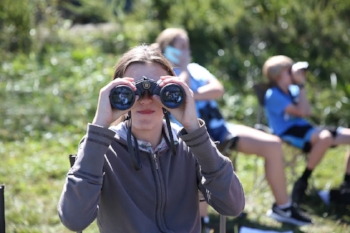

Kettles over Mahogany Rock
BRDC staff and volunteers spent Saturday through Monday looking up!

7th Graders Discover Hawk Migration
Jim Keighton of Blue Ridge Birders hosted BRDC and 19 Grayson Highlands seventh graders for a day of counting migrating hawks.

Mahogany Rock Hawk Watch
On September 23, thirty seventh graders from Grayson County Public Schools attended the Mahogany Rock Hawk Watch to experience the niche dedication of Hawk Counters and the mass migration of Broad-winged Hawks. Jim Keighton from the Blue Ridge Birders has been recording the migration of birds of prey for nearly twenty years! Each fall Jim sets up his swivel chair and interpretive displays along the parkway and begins scanning the sky. Not only does he diligently track the migration but he also takes the time to educate the passerby about the migration occurring overhead.

Hawk Watching with Galax High School
Mahogany Rock Hawk Watch with Galax HS Biology Students. On September 24th, BRDC hosted this year’s final Avian Adventures program at Mahogany Rock Overlook on the Blue Ridge Parkway. Teachers Emily Brown and Sam Starkey brought 12 kids for a day of hawk observations and discussions on migration.BRDC guides William Roberts and Scott Jackson-Ricketts began the program with a focus on a map, compass and questions about migratory patterns and the dynamics of energy saving flight techniques.